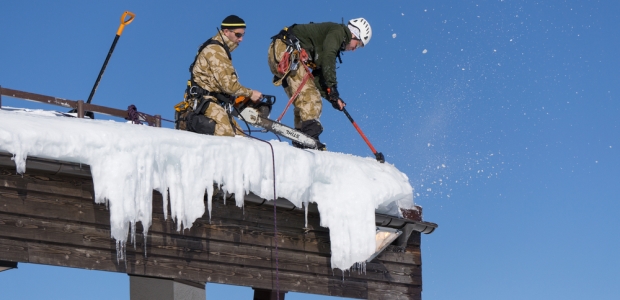
OSHA Warns of Rooftop Snow Removal Hazards
Several recent incidents, including one fatality, involved workers who fell through skylights.
OSHA has sent out a notice reminding employers and workers who remove snow from rooftops and other building structures to be aware of the hazards and safeguards associated with the work, saying that several recent incidents involved workers falling through skylights, one of which resulted in a death. Employers should evaluate the hazards of snow removal tasks and plan how to do the work safely.
"A surface that is weighed down by snow may be at risk of collapsing, so it must be inspected by a competent person to determine if it is structurally safe for workers to access it. Snow-covered rooftops can hide hazards such as skylights that workers can fall through. Electrical hazards may also exist from overhead power lines or snow removal equipment," according to the notice. It advises employers to use snow removal methods that do not involve workers going on roofs when possible and also to select the right type of equipment to use, such as ladders or aerial lifts; PPE such as personal fall arrest systems and non-slip safety boots; and ensure workers are trained on how to properly use them.
More information is available in an OSHA Hazard Alert, "Falls and Other Hazards to Workers Removing Snow from Rooftops and Other Elevated Surfaces," and on the agency's Winter Weather website.
OSHA notes in the alert that, every year, some workers die or are seriously injured while performing snow or ice removal from rooftops and other building structures, such as decks. It says OSHA has investigated 16 such serious injuries or fatalities in the past 10 years, including these:
- A worker was removing snow from a roof when he lost his balance and slid off the roof. He fell and struck his head on construction materials that were being stored below the roof, suffering a fatal head injury.
- A worker was laying grid lines and shoveling snow on a second-floor deck. An elevator shaft opening was covered with a plastic tarp, with temporary guardrails installed around a portion of the shaft opening. The worker, who was not wearing any fall protection, fell 30 feet through the unguarded portion of the elevator shaft opening and was killed.
- Four workers were building a second-floor room addition. One was standing on a 12-foot aluminum ladder, attempting to clean snow from a low-slope roof 10 feet above ground. The feet of the ladder slid and the worker fell, striking his head on the ladder and then on the concrete driveway. He died several days
later.
- A worker was shoveling snow from the roof of a residential construction site. He fell from a height of more than 11 feet and was fatally impaled by a scaffold upright.
Besides fall hazards, workers can face hazards of amputations, eye injuries, and other injuries associated with the use of snowblowers and other mechanized equipment, according to the alert.